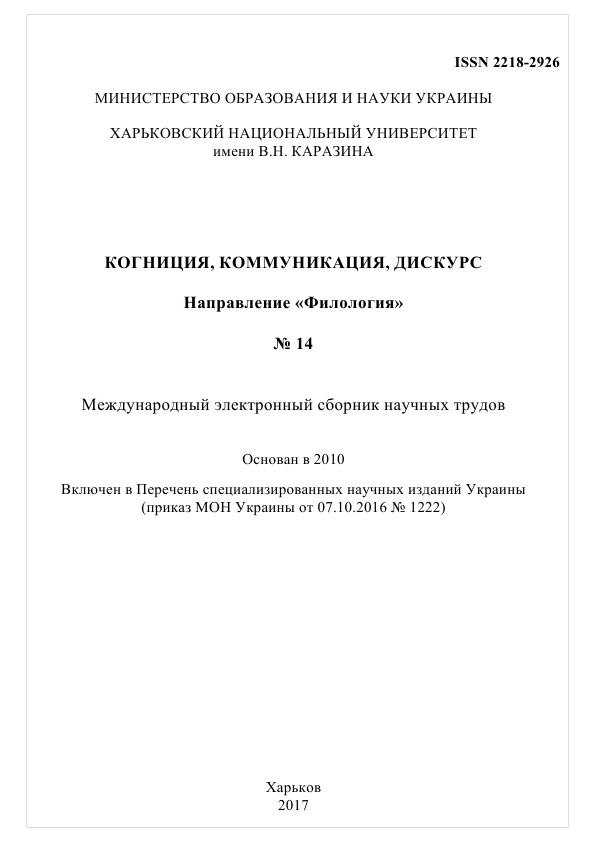Metaphors of depressive emotions in psychopathological discourse: a cognitive linguistic analysis
Abstract
This paper addresses metaphor and focuses on the role of metaphor
in conceptualization of emotion experience of depression. The objective of this paper is two-fold. It aims (1) to appease the criticism of negligence with respect to big data and real discourses that conceptual metaphor theory is presently facing and (2) to expose and analyse with a cognitive linguistic methodology metaphorizations of depressive emotions in psychopathological discourse. In accordance with this objective, the investigation behind this paper is fuelled by big metaphorical data recruited from pieces of modern English psychopathological discourse on major and manic depression recorded in the form of two single-author depression memoirs. Metaphors of depressive emotions and their entailments organize within these pieces ramified metaphorical systems that reflect subcategorization of emotion experience by the depressive mind. Metaphors in these systems are of various types; they are based on bodily and cultural experiences, have different cognitive functions and may be archetypal in nature. Their targets are distinct emotion concepts. Their sources belong to diverse domains of human experience. Metaphorical meanings for the depressive emotions expose qualitative aspects of emotion experience of depression in its variation and subtlety. Metaphors of depressive emotions in the data encompass creative and conventional conceptualizations. The data allow an assumption that whereas conventional metaphors perform the function of understanding an emotion experience and naming it, creative metaphors expose in this experience its most elusive aspects and their cognitive function is augmented by the aesthetic one. Apart from implications for cognitive linguistics, the findings summarized in this paper are suggestive for research in phenomenology of depression, in clinical psychology and psychopathology and in cognitive poetics and literary theory and criticism. In prospect, this paper will grow into a larger-scale research on the issue of metaphorical creativity.
Downloads
References
Clausner, T., & Croft, W. (1997). Productivity and Schematicity in Metaphors. Cognitive Science, 21(3), 247–82.
Deignan, A. (1999). Corpus-based Research into Metaphor. In: L. Cameron, G. Low (Eds.). Researching and Applying Metaphor (pp. 177–99). Cambridge: Cambridge University Press.
Deignan, A. (2005). Metaphor and Corpus Linguistics. Amsterdam: John Benjamins.
Kövecses, Z. (2010). A New Look at Metaphorical Creativity in Cognitive Linguistics. Cognitive Linguistics, 21(1), 663–97.
Lakoff, G. (1990). The Invariance Hypothesis: Is Abstract Reason Based on Image Schemas? Cognitive Linguistics, 1, 39–74.
Lakoff, G. (1993). The Contemporary Theory of Metaphor. In: A. Ortony (Ed.). Metaphor and Thought (pp. 202–51). New York: Cambridge University Press.
Lakoff, G., & Johnson, M. (1980a). Conceptual Metaphor in Everyday Language. The Journal of Philosophy, 77(8), 453–86.
Lakoff, G., & Johnson, M. (1980b). Metaphors We Live By. Chicago: Chicago University Press.
Lakoff, G., & Johnson, M. (1999). Philosophy in the Flesh: the Embodied Mind and its Challenge to Western Thought. New York: New York Basic Books.
Pragglejaz Group. (2007). MIP: A Method for Identifying Metaphorically Used Words in Discourse. Metaphor and Symbol, 22(1), 1–39.
Ritchie, L.D. (2003). ”ARGUMENT IS WAR” – Or is it a Game of Chess? Multiple Meanings in the Analysis of Imiplicit Metaphors. Metaphor and Symbol, 18(2), 125–46.
Scherer, K.R. (2005). What are Emotions? And How can They be Measured?. Social Science Information, 44(4), 695–729.
Shevchenko, I.S., & Morozova, Ye.I. (2003). Diskurs kak myslekommunikativnoe obrazovanie [Discourse as a Mental and Communicative Phenomenon]. Visnyk Kharkiv. nats. un-tu im. V.N. Karazina. – V.N. Karazin National Univ. Messenger, 586, 33–38 (in Russian).
Stefanowitsch, A. (2007). Words and their Metaphors. In: A. Stefanowitch, & S.Th. Gries. (Eds.). Corpus-based Approaches to Metaphor and Metonymy (pp. 64–105). Berlin: Mouton de Gruyter
Vakhovska, O.V. (2017). Metaphor in First-Person Verbal Report on Emotion Experience of Depression (MSc Thesis in Cognitive Science). Osnabrück: Osnabrück University.
Walter, J., & Helmig, J. (2005). Metaphors as Agents of Signification. Towards a Discursive Analysis of Metaphors. Metaphors in Political Science. ECPR Granada Workshop
Zhabotynska, S.A. (2011). Kontseptualnaya metafora: protsedura analiza dlya mnozhestvennykh dannykh [Conceptual Metaphor: A Procedure of Big Data Analysis]. Zbirnyk statey za materialamy VII Mizhnarodnoyi konferentsiyi: Aktualni problemy mentalingvistiki. – A Collection of Papers from 7th Int. Conference: Current Issues of Mentalinguistics. Cherkasy, 3–6 (in Russian).
Authors, who publish with this journal, accept the following conditions:
The authors reserve the copyright of their work and transfer to the journal the right of the first publication of this work under the terms of the Creative Commons Attribution License (CC BY), which allows other persons to freely distribute a published work with mandatory reference to the authors of the original work and the first publication of the work in this journal.
Authors have the right to enter into separate additional agreements for the non-exclusive dissemination of the work in the form in which it was published by this journal (for example, to post the work in the electronic institutions' repository or to publish as part of a monograph), provided that the link to the first publication of the work in this journal is given.
The journal policy allows and encourages the authors to place the manuscripts on the Internet (for example, in the institutions' repositories or on personal websites), both before the presentation of this manuscript to the editorial board and during review procedure, as it contributes to the creation of productive scientific discussion and positively affects the efficiency and dynamics of citing the published work (see The Effect of Open Access).




